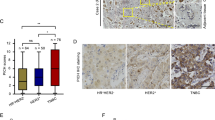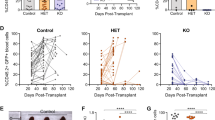Abstract
Multiple copies in T-cell maligancy (MCT-1) is a putative oncogene initially identified in a human T-cell lymphoma. Forced expression of MCT-1 has recently been shown to induce cell transformation and proliferation, as well as to activate survival-related PI-3K/AKT pathways protecting cells from apoptosis. MCT-1 protein is stabilized in response to DNA damage. The impact of MCT-1 overexpression on DNA damage response remains unknown. Here, we show that MCT-1 deregulates cell cycle checkpoints. The phosphorylation of genomic stabilizers H2AX and NBS1 are enhanced in MCT-1-overexpressing cells. Forced expression of MCT-1 significantly increases the number of DNA damage-induced foci involving γ-H2AX and 53BP1. In MCT-1-overexpressing cells, the proportion of S-phase cell population is preferentially increased after exposure to γ-irradiation compared to controls. Knockdown of endogenous MCT-1 using an siRNA approach attenuates the H2AX phosphorylation and the G1/S checkpoint defect. Furthermore, MCT-1 is capable of transforming immortalized human mammary epithelial cells and promoting genomic instability. These data shed light on the role of MCT-1 in the cellular response to DNA damage and its involvement in malignant transformation.
This is a preview of subscription content, access via your institution
Access options
Subscribe to this journal
Receive 50 print issues and online access
$259.00 per year
only $5.18 per issue
Buy this article
- Purchase on Springer Link
- Instant access to full article PDF
Prices may be subject to local taxes which are calculated during checkout






Similar content being viewed by others
References
Aten JA, Stap J, Krawczyk PM, van Oven CH, Hoebe RA, Essers J and Kanaar R . (2004). Science, 303, 92–95.
Bassing CH, Chua KF, Sekiguchi J, Suh H, Whitlow SR, Fleming JC, Monroe BC, Ciccone DN, Yan C, Vlasakova K, Livingston DM, Ferguson DO, Scully R and Alt FW . (2002). Proc. Natl. Acad. Sci. USA, 99, 8173–8178.
Burma S, Chen BP, Murphy M, Kurimasa A and Chen DJ . (2001). J. Biol. Chem., 276, 42462–42467.
Celeste A, Difilippantonio S, Difilippantonio MJ, Fernandez-Capetillo O, Pilch DR, Sedelnikova OA, Eckhaus M, Ried T, Bonner WM and Nussenzweig A . (2003a). Cell, 114, 371–383.
Celeste A, Fernandez-Capetillo O, Kruhlak MJ, Pilch DR, Staudt DW, Lee A, Bonner RF, Bonner WM and Nussenzweig A . (2003b). Nat. Cell Biol., 5, 675–679.
Celeste A, Petersen S, Romanienko PJ, Fernandez-Capetillo O, Chen HT, Sedelnikova OA, Reina-San-Martin B, Coppola V, Meffre E, Difilippantonio MJ, Redon C, Pilch DR, Olaru A, Eckhaus M, Camerini-Otero RD, Tessarollo L, Livak F, Manova K, Bonner WM, Nussenzweig MC and Nussenzweig A . (2002). Science, 296, 922–927.
Chen HT, Bhandoola A, Difilippantonio MJ, Zhu J, Brown MJ, Tai X, Rogakou EP, Brotz TM, Bonner WM, Ried T and Nussenzweig A . (2000). Science, 290, 1962–1965.
Dierov J, Prosniak M, Gallia G and Gartenhaus RB . (1999). J. Cell Biochem., 74, 544–550.
DiTullio Jr RA, Mochan TA, Venere M, Bartkova J, Sehested M, Bartek J and Halazonetis TD . (2002). Nat. Cell Biol., 4, 998–1002.
Duensing S and Munger K . (2002). Oncogene, 21, 6241–6248.
Fernandez-Capetillo O, Chen HT, Celeste A, Ward I, Romanienko PJ, Morales JC, Naka K, Xia Z, Camerini-Otero RD, Motoyama N, Carpenter PB, Bonner WM, Chen J and Nussenzweig A . (2002). Nat. Cell Biol., 4, 993–997.
Furuta T, Takemura H, Liao ZY, Aune GJ, Redon C, Sedelnikova OA, Pilch DR, Rogakou EP, Celeste A, Chen HT, Nussenzweig A, Aladjem MI, Bonner WM and Pommier Y . (2003). J. Biol. Chem., 278, 20303–20312.
Hahn WC and Weinberg RA . (2002). N. Engl. J. Med., 347, 1593–1603.
Herbert GB, Shi B and Gartenhaus RB . (2001). Oncogene, 20, 6777–6783.
Kang JS and Krauss RS . (1996). Mol. Cell. Biol., 16, 3370–3380.
Malumbres M and Barbacid M . (2001). Nat. Rev. Cancer, 1, 222–231.
Morales JC, Xia Z, Lu T, Aldrich MB, Wang B, Rosales C, Kellems RE, Hittelman WN, Elledge SJ and Carpenter PB . (2003). J. Biol. Chem., 278, 14971–14977.
Paull TT, Rogakou EP, Yamazaki V, Kirchgessner CU, Gellert M and Bonner WM . (2000). Curr. Biol., 10, 886–895.
Petersen S, Casellas R, Reina-San-Martin B, Chen HT, Difilippantonio MJ, Wilson PC, Hanitsch L, Celeste A, Muramatsu M, Pilch DR, Redon C, Ried T, Bonner WM, Honjo T, Nussenzweig MC and Nussenzweig A . (2001). Nature, 414, 660–665.
Prosniak M, Dierov J, Okami K, Tilton B, Jameson B, Sawaya BE and Gartenhaus RB . (1998). Cancer Res., 58, 4233–4237.
Rogakou EP, Boon C, Redon C and Bonner WM . (1999). J. Cell Biol., 146, 905–916.
Shi B, Hsu HL, Evens AM, Gordon LI and Gartenhaus RB . (2003). Blood, 102, 297–302.
Stiff T, O'Driscoll M, Rief N, Iwabuchi K, Lobrich M and Jeggo PA . (2004). Cancer Res., 64, 2390–2396.
Wang H, Zeng ZC, Bui TA, Sonoda E, Takata M, Takeda S and Iliakis G . (2001). Oncogene, 20, 2212–2224.
Ward IM and Chen J . (2001). J. Biol. Chem., 276, 47759–47762.
Ward IM, Minn K, Jorda KG and Chen J . (2003). J. Biol. Chem., 278, 19579–19582.
Acknowledgements
We thank Dr V Graig Jordan and Dr Yossi Shiloh for helpful discussions and providing reagents, and Anne Croisetiere and Dr Bin Chen for technical support. A Merit Review Award from the Department of Veterans Affairs (RBG) and Avon Foundation Pilot Project Award (RBG) supported this work.
Author information
Authors and Affiliations
Corresponding author
Rights and permissions
About this article
Cite this article
Hsu, HL., Shi, B. & Gartenhaus, R. The MCT-1 oncogene product impairs cell cycle checkpoint control and transforms human mammary epithelial cells. Oncogene 24, 4956–4964 (2005). https://doi.org/10.1038/sj.onc.1208680
Received:
Revised:
Accepted:
Published:
Issue Date:
DOI: https://doi.org/10.1038/sj.onc.1208680
Keywords
This article is cited by
-
Cyclin B/CDK1 and Cyclin A/CDK2 phosphorylate DENR to promote mitotic protein translation and faithful cell division
Nature Communications (2022)
-
The oncogene Mct-1 promotes progression of hepatocellular carcinoma via enhancement of Yap-mediated cell proliferation
Cell Death Discovery (2021)
-
DENR promotes translation reinitiation via ribosome recycling to drive expression of oncogenes including ATF4
Nature Communications (2020)
-
Identification of transcripts with short stuORFs as targets for DENR•MCTS1-dependent translation in human cells
Scientific Reports (2017)
-
Oncogenic MCT-1 activation promotes YY1-EGFR-MnSOD signaling and tumor progression
Oncogenesis (2017)



